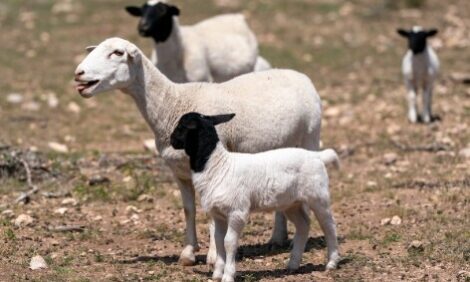



Manage bull preputial injuries to reduce economic loss
Brangus, Beefmasters and Santa Gertrudis are the most susceptible to preputial injuriesPreputial injuries in bulls can cause considerable economic loss and significantly impact a producer's breeding plans. Understanding the severity of a prepuce injury is critical to the outcome of the condition.
Bulls with pendulous sheaths and polled breeds have a high incidence of preputial injuries. A significant relationship appears to exist between a pendulous sheath and the tendency of habitual eversion of the prepuce. In polled breeds, this tendency may be due to incomplete development of the preputial muscles. Polled breeds with pendulous sheaths, such as Brangus, Beefmasters and Santa Gertrudis, are the most susceptible to preputial injuries.
Prepuce injuries can be categorized as lacerations, avulsions, contusions, frostbite and abrasions. Lacerations, contusions and abrasions are most common in range conditions. Habitual eversion can cause injury and infection that eventually results in phimosis of stenosis of the prepuce. If there are plans to use the bull for future breeding, surgery is often necessary.
Infection of the prepuce may also lead to abscess formation. The location of the abscess is usually midway between the preputial opening and the scrotum. Bulls with preputial abscesses seldom recover enough to be used for breeding purposes. Paraphimosis (prolapsed penis) due to injury of the penis or frostbite is serious and often results in the bull being sold for slaughter at a considerable economic loss.
Acute preputial prolapse should be managed conservatively. Therapy involves cleaning the area and prolapse reduction. The author recommends preputial massage using a formula of 0.5 kg of lanolin containing 60 ml scarlet oil and 60 ml of oxytetracycline (100mg or 200mg) called “Petercillin" or "Petermycin." The lanolin protects the tissue and prevents dehydration. The scarlet oil promotes epithelialization and healing, while the tetracycline provides a broad-spectrum antibiotic.
The benefits of preputial massage for acute cases of preputial prolapse cannot be over-emphasized. Fifteen to 20 minutes of continuous massage will have a marked effect in reducing edema. The objective is to massage the edema or swelling of the prolapsed tissue and replace the prolapse in the sheath, thus protecting the tissue from exposure and additional trauma. Once reduction is accomplished, preputial retention is necessary and can be done by using either a purse string suture or the tape/tube retention technique. The preputial retention device is left on for two weeks to let the prepuce heal and reduce the edema. Then, the preputial retention device should be removed and the bull observed closely for two to three days to ensure it does not prolapse.
If prolapse recurs, it should be reduced and therapy continued for 10 to 14 days. If the prepuce heals and the bull still cannot keep the prepuce inside the sheath, surgery is recommended. In this case, owners should let the prepuce heal and give the bull sexual rest for at least eight weeks. This should allow enough time for the prepuce to heal and shrink the amount of scar tissue if surgery is needed. After the healing process, reefing surgery or preputial amputation surgery is indicated to remove the excess prepuce or phimosis of the preputial cavity.
Chronic preputial prolapse with severe tissue damage, edema and necrosis is often the result of neglect or poor observation. Often, the inflammation and necrotic tissue on the prepuce is so extensive at the time of initial examination, it is extremely difficult to make an accurate prognosis. In these cases, a poor prognosis must be given, and the owner should be advised that seven to 10 days of therapy may be necessary before attempting prognosis. Often, chronic prolapses cannot be reduced initially and require extensive therapy before reduction can be accomplished.
If extensive fibrosis and stenosis are present, reduction may not be possible. Treatment involves hydrotherapy, soaking the prolapsed prepuce with Epsom salt and betadine solution for 30 minutes, then massaging with the previously described formula for 10 to 15 minutes to reduce the prolapse. In cases where reduction cannot be accomplished after every treatment, the lanolin formula should be applied to the prolapsed tissue, a two-inch stockinette rolled over the prepuce and a pressure bandage applied. Rubber tubing such as a garden hose or endotracheal tube is placed in the prolapsed prepuce to provide an opening for urine. A pressure bandage is applied using gauze over the stockinette. A pressure bandage can be created using vet wrap and elastic tape applied with moderate pressure. The pendulous prolapse is then supported with either a diaper or sling depending on the temperament of the bull. The dressing should be changed daily and accompanied by attempts to reduce the prolapse. Once the inflammation and swelling have subsided, the degree of fibrosis can be evaluated.
Surgical intervention is usually considered if fibrosis and stenosis have occurred. However, caution should be exercised to allow sufficient time for complete healing to occur. This often requires six to eight weeks of sexual rest. Reevaluation after the rest period allows not only a better assessment of the need for surgery but also the opportunity to reevaluate genetic and economic factors. Clients should be advised that a positive breeding outcome is not guaranteed and obtaining another bull should be considered.
The British breeds often do not possess enough preputial tissue to permit the removal of a fibrotic or stenotic section and still allow for sufficient penile extension to accomplish intromission. Surgery is common in Bos. indicus and exotic breeds, which have pendulous sheaths and extensive amounts of preputial tissue.
In summary, prompt and appropriate care is key to the successful management of preputial injuries in bulls. Clients must be made aware of the serious nature of preputial injuries and the importance of prompt medical attention. The objective of the therapy is to control contamination, prevent further trauma and reduce fibrosis. This requires prompt reduction of the prolapsed prepuce. Once reduced, the bovine prepuce has a tremendous healing capacity.


